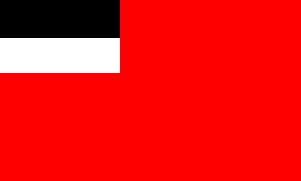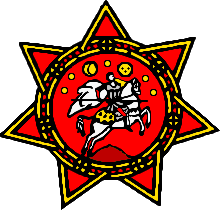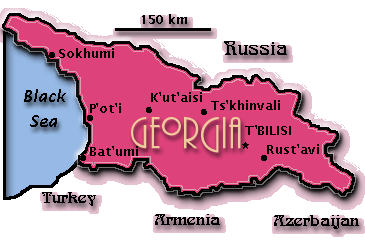Georgia



Geography
Note: Georgia is currently besieged by interethnic strife in its Abkhazian and South Ossetian enclaves.Location: Southwestern Asia, bordering the Black Sea, between Turkey and Russia
Regional Statistics: Area:
total area: 69,700 sq km
land area: 69,700 sq km
comparative area: slightly larger than South CarolinaLand boundaries: total 1,461 km, Armenia 164 km, Azerbaijan 322 km, Russia 723 km, Turkey 252 km
Coastline: 310 km
Maritime claims:
note: 12 nm in 1973 USSR-Turkish Protocol concerning the sea boundary between the two states in the Black Sea; Georgia claims the coastline along the Black Sea as its international waters, although it cannot control this area and the Russian navy and commercial ships transit freelyInternational disputes: none
Climate: warm and pleasant; Mediterranean-like on Black Sea coast
Terrain: largely mountainous with Great Caucasus Mountains in the north and Lesser Caucasus Mountains in the south; Kolkhida Lowland opens to the Black Sea in the west; Mtkvari River Basin in the east; good soils in river valley flood plains, foothills of Kolkhida Lowland
Natural resources: forest lands, hydropower, manganese deposits, iron ores, copper, minor coal and oil deposits; coastal climate and soils allow for important tea and citrus growth
Land use:
arable land: NA%
permanent crops: NA%
meadows and pastures: NA%
forest and woodland: NA%
other: NA%Irrigated land: 4,660 sq km (1990)
Environment:
current issues: air pollution, particularly in Rust'avi; heavy pollution of Mtkvari River and the Black Sea; inadequate supplies of safe drinking water; soil pollution from toxic chemicals
natural hazards: NA
international agreements: NA
People
Population: 5,681,025 (July 1994 est.)
Population growth rate: 0.81% (1994 est.)
Birth rate: 16.11 births/1,000 population (1994 est.)
Death rate: 8.69 deaths/1,000 population (1994 est.)
Net migration rate: 0.65 migrant(s)/1,000 population (1994 est.)
Infant mortality rate: 23.4 deaths/1,000 live births (1994 est.)
Life expectancy at birth:
total population: 72.84 years
male: 69.16 years
female: 76.7 years (1994 est.)Total fertility rate: 2.18 children born/woman (1994 est.)
Nationality:
noun: Georgian(s)
adjective: GeorgianEthnic divisions: Georgian 70.1%, Armenian 8.1%, Russian 6.3%, Azeri 5.7%, Ossetian 3%, Abkhaz 1.8%, other 5%
Religions: Georgian Orthodox 65%, Russian Orthodox 10%, Muslim 11%, Armenian Orthodox 8%, unknown 6%
Languages: Armenian 7%, Azeri 6%, Georgian 71% (official), Russian 9%, other 7%
Literacy: age 9-49 can read and write (1970)
total population: 100%
male : 100%
female: 100%Labor force: 2.763 million
by occupation: industry and construction 31%, agriculture and forestry 25%, other 44% (1990)
Art
Government
Names:
conventional long form: Republic of Georgia
conventional short form: Georgia
local long form: Sak'art'velos Respublika
local short form: Sak'art'velo
former: Georgian Soviet Socialist RepublicDigraph: GG
Type: republic
Capital: T'bilisi
Administrative divisions: 2 autonomous republics (avtomnoy respubliki,singular - avtom respublika); Abkhazia (Sokhumi), Ajaria (Bat'umi)
note: the administrative centers of the autonomous republics are included in parentheses; there are no oblasts - the rayons around T'bilisi are under direct republic jurisdictionIndependence: 9 April 1991 (from Soviet Union)
National holiday: Independence Day, 9 April (1991)
Constitution (KOI8 font): adopted August 24, 1995
Legal system: based on civil law system
Suffrage: 18 years of age; universal
Executive branch:
chief of state: President Eduard Amvrosiyevich SHEVARDNADZE elected November 5, 1995 80% of the vote)
head of government: Prime Minister Otar PATSATSIA (since September 1993); Deputy Prime Ministers Avtandil MARGIANI, Zurab KERVALISHVILI (since NA), Tamaz NADARISHVILI (since September 1993), Teimuraz BASILIA (since NA)
cabinet: Council of MinistersLegislative branch: unicameral
Georgian Parliament (Supreme Soviet): elections last held November 5, 1995; results - percent of vote by party Union of Georgian Citizens 23.7% (90 seats), National Democrats 8% (31 seats), All-Georgian Revival Union 6.8% (25 seats). A 5% minimum is required to seat delegates; 54 parties total ran candidates. In 1993 -- representatives of 26 parties elected; Peace Bloc, October 11, Unity, National Democratic Party, and the Greens Party won the largest representationJudicial branch: Supreme Court
Political parties and leaders: Merab Kostava Society, Vazha ADAMIA, chairman; Traditionalists' Union, Akaki ASATIANI, chairman; Georgian Social Democratic Party, Guram MUCHAIDZE, chairman; Green Party, Zurab ZHVANIA, chairman; Georgian Popular Front (GPF), Nodar NATADZE, chairman; National Democratic Party (NDP), Gia CHANTURIA, chairman; National Independence Party (NIP), Irakliy TSERETELI, chairmen; Charter 1991 Party, Tedo PATASHVILI, chairman; Peace Bloc; Unity; October 11
Other political or pressure groups: supporters of ousted President Zuiad GAMSAKHURDIA (deceased 1 January 1994) boycotted the October elections and remain a source of opposition and instability
Member of: BSEC, CIS, CSCE, EBRD, ECE, IBRD, IDA, ILO, IMF, IMO, INMARSAT, IOC, ITU, NACC, UN, UNCTAD, UNESCO, UNIDO, UPU, WHO
Diplomatic representation in US:
chief of mission: Ambassador Petr CHKHEIDZE
chancery : (temporary) Suite 424, 1511 K Street NW, Washington, DC
telephone : (202) 393-6060US diplomatic representation:
chief of mission: Ambassador Kent N. BROWN
embassy: #25 Antoneli Street, T'bilisi 380026
mailing address: use embassy street address
telephone: (7) 8832-98-99-68
FAX: (7) 8832-93-37-59
Economy
CIA Overview: Georgia's economy has traditionally revolved around Black Sea tourism; cultivation of citrus fruits, tea, and grapes; mining of manganese and copper; and a small industrial sector producing wine, metals, machinery, chemicals, and textiles. The country imports the bulk of its energy needs, including natural gas and coal. Its only sizable domestic energy resource is hydropower. Since 1990, widespread conflicts, e.g., in Abkhazia, South Ossetia, and Mengrelia, severely aggravated the economic crisis resulting from the disintegration of the Soviet command economy in December 1991. Throughout 1993, much of industry was functioning at only 20% of capacity; heavy disruptions in agricultural cultivation were reported; and tourism was shut down. The country is precariously dependent on US and EU humanitarian grain shipments, as most other foods are priced beyond reach of the average citizen. Georgia is also suffering from an acute energy crisis, as it is having problems paying for even minimal imports. Georgia is pinning its hopes for recovery on reestablishing trade ties with Russia and on developing international transportation through the key Black Sea ports of P'ot'i and Bat'umi.
National product: GDP - purchasing power equivalent - $7.8 billion (1993 estimate from the UN International Comparison Program, as extended to 1991 and published in the World Bank's World Development Report 1993; and as extrapolated to 1993 using official Georgian statistics, which are very uncertain because of major economic changes since 1990)
National product real growth rate: -35% (1993 est.)
National product per capita: $1,390 (1993 est.)
Inflation rate (consumer prices): 40.5% per month (2nd half 1993 est.)
Unemployment rate: officially less than 5% but real unemployment may be up near 20%, with even larger numbers of underemployed workers; real unemployment may be up near 20% with even larger numbers of underemployed workers
Budget:
revenues: $NA
expenditures: $NA, including capital expenditures of $NAExports: $NA
commodities: citrus fruits, tea, wine, other agricultural products; diverse types of machinery; ferrous and nonferrous metals; textiles; chemicals; fuel re-exports
partners: Russia, Turkey, Armenia, Azerbaijan (1992)Imports: $NA
commodities: fuel, grain and other foods, machinery and parts, transport equipment
partners: Russia, Azerbaijan, Turkey (1993)External debt: $100 million to $200 million (1993 est.)
Industrial production: growth rate -27% (1993); accounts for 36% of GDP
Electricity:
capacity: 4,875,000 kW
production: 15.8 billion kWh
consumption per capita : 2,835 kWh (1992)Industries: heavy industrial products include raw steel, rolled steel, airplanes; machine tools, foundry equipment, electric locomotives, tower cranes, electric welding equipment, machinery for food preparation and meat packing, electric motors, process control equipment, instruments; trucks, tractors, and other farm machinery; light industrial products, including cloth, hosiery, and shoes; chemicals; wood-working industries; the most important food industry is wine
Agriculture: accounts for 41% of GDP; accounted for 97% of former USSR citrus fruits and 93% of former USSR tea; important producer of grapes; also cultivates vegetables and potatoes; dependent on imports for grain, dairy products, sugar; small livestock sector
Illicit drugs: illicit cultivator of cannabis and opium poppy; mostly for domestic consumption; used as transshipment point for illicit drugs to Western Europe
Economic aid:
recipient: heavily dependent on US for humanitarian grain shipments; EC granted around $70 million in trade credits in 1992 and another $40 million in 1993; Turkey granted $50 million in 1993; smaller scale credits granted by Russia and ChinaCurrency: coupons introduced in April 1993 to be followed by introduction of the lari in 1995; in July 1993 use of the Russian ruble was banned
Exchange rates: NA
Fiscal year: calendar year
Communications
Railroads: 1,570 km, does not include industrial lines (1990)
Highways:
total: 33,900 km
paved and gravelled: 29,500 km
unpaved: earth 4,400 km (1990)Pipelines: crude oil 370 km; refined products 300 km; natural gas 440 km (1992)
Ports: coastal - Bat'umi, P'ot'i, Sokhumi
Merchant marine: 41 ships (1,000 GRT or over) totaling 575,823 GRT/882,110 DWT, bulk cargo 14, oil tanker 27
Airports:
total: 37
usable: 27
with permanent-surface runways : 14
with runways over 3,659 m: 0
with runways 2,440-3,659 m : 10
with runways 1,060-2,439 m: 4
note: a C-130 can land on a 1,060-m airstripTelecommunications: poor telephone service; as of mid-1993, 672,000 telephone lines providing 14 lines per 100 persons; 339,000 unsatisfied applications for telephones (31 December 1990); international links via landline to CIS members and Turkey; low capacity satellite earth station and leased international connections via the Moscow international gateway switch with other countries; international electronic mail and telex service available
Note: transportation network is disrupted by ethnic conflict, criminal activities, and fuel shortages
Defense Forces
Branches: Army, Air Force, Navy, Interior Ministry Troops, Border Guards
Manpower availability: males age 15-49 1,362,818; fit for military service 1,081,624; reach military age (18) annually 42,881 (1994 est.)
Defense expenditures: $NA, NA% of GNP
Note: Georgian forces are poorly organized and not fully under the government's control.
CIA Data Files (1994)
This page was last up-dated: